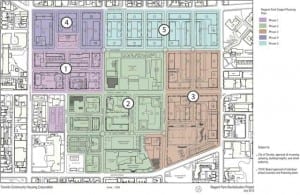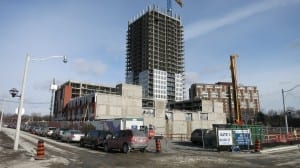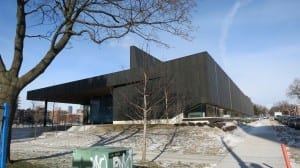The history of land-use planning in Regent Park reflects the worldwide history of land-use planning
A May 16, 2018 CBC article is entitled: “Decision quietly made by Toronto Community Housing sparks concern in Regent Park: TCH acknowledges it should have told residents sooner new developers could be moving in.”
The concluding paragraphs of the article read:
With the agency committing to be more transparent with its decisions, resident Michelle Basha is cautiously optimistic.

Map showing the planned phases of redevelopment of Regent Park, image courtesy of TCHC. This image has been downloaded from http://urbantoronto.ca/news/2012/09/tchc-and-daniels-unveil-plans-phase-three-regent-park-revitalization
“Based on the fact that we are here because we’ve been left in the dark, it’s wait to see,” Basha said.
Until then, she and other residents say they plan to hold the agency to account, to make sure it follows through on its promises.
“Right now it’s just air in the wind.”
[End]
Previous posts about Regent Park
Click here for previous posts about Regent Park >
I’ve been writing about the history of land-use planning in Regent Park and elsewhere for some time.
Within the larger picture of the history of land-use planning in Toronto and elsewhere in the world over the past century, the Regent Park story serves as an entry point, by which evolving narratives related to housing, social class, and power structures in society can be understood, as noted at previous posts:
Ken Greenberg speaks of lessons from pioneering global cities
Early National Film Board depictions of Regent Park
The role that institutions such as the National Film Board have played over the past half-century, in the days when I imagine the NFB did indeed have a measure of influence on what people thought, about any number of topics, is of particular interest to me.
The NFB documentary film format, as it emerged during the Second World War and postwar years, positioned itself as dealing with what could be described as everyday life – which what could be described as everyday reality, that is.
The construction of that reality, in the viewer’s mind, however, quite consistently involved rhetorical framing that led to the construction of perceptions that accorded more closely with the viewpoint of NFB producers than it did with the actual, moment-to-moment, everyday realities of individuals and families depicted in such films.
The National Film Board approach to filmmaking that is evident, in particular in an early documentary about Regent Park as described at an earlier post, echoes themes that are also at the heart of the conceptual framework, adopted by the original Walt Disney animators, as described at still another previous post:
Differences in history of land-use planning: Mississauga compared to Toronto
The history – and attendant culture – of land-use planning differs markedly from one municipality to another. The difference between Mississauga and Toronto with regard to this topic, by way of example, is among the most remarkable things that I have learned during my twenty-one-year stay in south Etobicoke (as I have mentioned elsewhere, we are moving out soon).
By way of conclusion, regarding the role that citizens play, in different municipalities in Ontario, if you want to see a close match between rhetoric and reality, as it relates to actual (actual as opposed to rhetorical) citizen participation in land-use planning, look to Mississauga:



Leave a Reply
Want to join the discussion?Feel free to contribute!